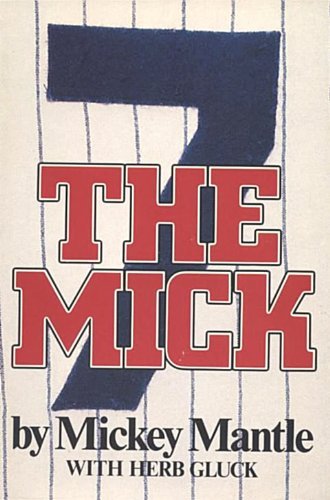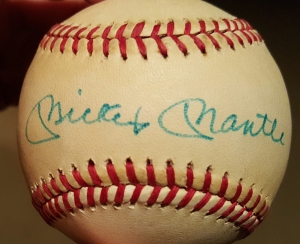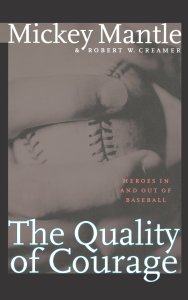This continues a series on the best Yankees at different positions. Today: center field.
Center field might rival or surpass catcher as the position with the strongest Yankee tradition.
1, Mickey Mantle
 This is why center field might be even stronger than catcher: You don’t have a clear No. 1. As great as Bill Dickey was, Yogi Berra was the clear top choice at catcher, what with his three MVP awards and all his World Series records. But both Mickey Mantle and Joe DiMaggio won three MVP awards. Both are Hall of Famers (as are Berra and Dickey).
This is why center field might be even stronger than catcher: You don’t have a clear No. 1. As great as Bill Dickey was, Yogi Berra was the clear top choice at catcher, what with his three MVP awards and all his World Series records. But both Mickey Mantle and Joe DiMaggio won three MVP awards. Both are Hall of Famers (as are Berra and Dickey).
So what counts more? DiMaggio’s 56-game hitting streak or Mantle’s Triple Crown? DiMaggio’s .325 career batting average or Mantle’s 536 career homers? DiMaggio led the league twice each in homers, RBI and batting average (just not in the same season). Mantle led four times in homers but once each (in the Triple Crown year, obviously) in RBI and batting. Each was such an icon, he was mentioned in song lyrics and pitched products on TV (I’ve embedded songs and commercials in the YouTube videos at the end of this post).
Each was a leading sports celebrity of his time, DiMaggio renowned for his grace on the field and his marriage to Marilyn Monroe, Mantle famed for his tape-measure homers, country-boy personality and carousing.
In the 1940s, baseball fans debated whether DiMaggio or Ted Williams was the best player, and in the ’50s and early ’60s, the debate was over Mantle and Willie Mays. Clearly both Yankees belong on any list of best baseball players ever.
Part of measuring Mantle vs. DiMaggio is weighing what they didn’t do: How do you account for all of Mantle’s injuries or for DiMaggio missing three prime years to military service during World War II?
 Here’s the statistical case to choose Mantle for the top spot:
Here’s the statistical case to choose Mantle for the top spot:
- He played more games in center: 1,742 to 1,634.
- Mantle hit more homers: 536 to 361.
- Mantle got more hits, 2,415 to 2,214.
- Mantle got more walks, 1,733 to 790 (some of these advantages are narrow enough to be explained by Mantle’s longer career, but not that one).
- Mantle led the league in walks five times (DiMaggio never did).
- Mantle led the league twice in intentional walks (the stat was not kept during DiMaggio’s career or for the first four years of Mantle’s).
- Mantle scored more runs, 1,676 to 1,390.
- Mantle led the league five times in runs scored (DiMaggio led the league once).
- Mantle led the league three times in on-base percentage (DiMaggio never did) and had a higher career OBP, .421 to .398.
- Mantle led the league four times in slugging (DiMaggio did it twice).
- Mantle led the league six times in OPS (four times topping 1.000). DiMaggio never led the league in OPS, but their career figures were identical, .977.
- Mantle hit for more total bases, 4,511 to 3,948. Each led the league in total bases three times.
- Mantle stole more bases: 153 to 30. Six seasons Mantle was in double figures for steals, a feat DiMaggio never accomplished.
- Mantle was faster down the first-base line, grounding into 113 career double plays in his longer career to 130 for DiMaggio (and the stat wasn’t kept his first three seasons). Mantle only twice topped 10 double plays in a season, and DiMaggio did it eight times.
 DiMaggio has fewer but significant statistical advantages:
DiMaggio has fewer but significant statistical advantages:
- He drove in more runs, 1,537 to 1,509, though all those walks, especially the intentional ones, explain that difference.
- DiMaggio slugged higher for his career, .579 to .557
- DiMaggio struck out only 369 times to 1,710 for Mantle, who led the league in strikeouts five times.
- DiMaggio doubled more times, 389 to 344.
- DiMaggio tripled more times, 131 to 72 (each led his league in triples once).
- DiMaggio topped 200 hits twice. Mantle never did (again, the walks help explain that).
For Mantle’s peak, from 1954 to 1962, he was better than DiMaggio. But Mantle’s final four years, 1965-68, really dragged down his career averages. DiMaggio’s only subpar year was his final season, 1951, the year their careers overlapped.
They both were incredible based on post-season play and championship contributions, which count heavily in my rankings. But here’s where I see Mantle with an advantage:
- DiMaggio won nine World Series and played in a 10th. Mantle won seven World Series and played in a 10th.
- Both of their batting averages were a bit down facing the National League’s best teams: DiMaggio hitting .271 in the World Series and Mantle hitting .257.
- World Series pitchers walked Mantle a lot, 43 times vs. 19 for DiMaggio. That gave Mantle an OBP of .374, compared to .338 for DiMaggio.
- Mantle also slugged more in October, .535 vs. .422. That gave him a huge OPS advantage in the World Series, .908 to .760.
- Mantle had 40 World Series RBI, 10 more than DiMaggio.
- Mantle scored more World Series runs, 42 to 27.
- Mantle got more World Series hits, 59 to 54.
- Mantle did play more games in the World Series than DiMaggio, 65 to 51. That advantage explains some of those differences in career totals, but Mantle’s higher averages (except in batting) don’t reflect playing time.
- And even with more World Series games, Mantle grounded into only two double plays, compared to six for DiMaggio.
Here’s the big difference that sealed the advantage for Mantle in my view: He hit 18 World Series homers, breaking Babe Ruth’s record. DiMaggio hit eight homers, seventh all-time, but nowhere close to Mantle, who still holds the record. He holds the World Series records for homers, RBI, runs scored, walks and total bases. No one did more to help his teams win World Series than Mantle. His name appears 15 times in the rankings of World Series batting leaders, compared to nine for DiMaggio, who doesn’t hold any records.
I have to admit a bias here: Mantle was a childhood hero and I’ve read three books he “wrote” (ghost writers were clearly involved) as well as two biographies. If this were a dead-even tie, my childhood bias would give it to Mantle. But I think he wins on the basis of superior power and speed, especially in the World Series.
Mantle co-starred with Maris in perhaps the worst baseball movie (maybe the worst movie) of all-time. Even as a young boy idolizing both players, I could barely stand to watch “Safe at Home.”
I admired The Mick’s late-life admission that he was an alcoholic, a philanderer and a horrible role model. But I didn’t know any of that when I was a little boy. I just knew he was incredible to watch play. I only saw him on TV, not in real life. But it was watching Mantle play, and studying his stats on baseball cards, that launched me on a life as a Yankee fan and baseball-stats geek.
2, Joe DiMaggio
OK, I’ve already pretty much told you all the reasons DiMaggio was pretty close to Mantle’s equal. If World War II hadn’t interrupted DiMaggio’s career in his prime, his career totals might have passed Mantle’s in many respects.
While DiMaggio didn’t self-destruct with alcohol the way that Mantle did, Richard Ben Cramer’s outstanding biography depicts DiMaggio as a cheap, arrogant, controlling jerk. Mantle was a lousy husband and father, and those are two of the most important roles any man can play. But I’m pretty sure I’d prefer Mantle as a friend or as a ballplayer to encounter by chance in boyhood or as an adult. I think he was a nicer person, for all his many failings.
One of the most famous DiMaggio stories illustrates. Before I repeat it, I should admit my longtime suspicion that the story might be apocryphal: During their 1954 honeymoon in Japan, the Army asked Monroe to make a side trip to Korea to entertain the troops. When she returned to him, telling him about the warm welcome from the troops, she supposedly said, “You never heard such cheering,” and he responded, “Yes, I have.”
Well, if it’s true, he was a jerk to his new wife. Yes, he, too, had enjoyed the cheers of adoring crowds. But they each knew whom they were marrying. And only a jerk would try to one-up his wife’s enjoyment of entertaining the troops.
But, damn, he could play!
3, Bernie Williams
The consideration for the third spot shows how ridiculous Hall of Fame selection has become. Earle Combs is a Hall of Famer, elected by the Veterans Committee in 1970. Bernie Williams lasted just two years on the Baseball Writers Association of America ballot for the Hall of Fame. He’s a long shot, I suppose, for Veterans Committee selection someday. But he’s easily the better center fielder and he ranks third on this list.
Williams played 1,856 games in center for the Yankees, more than Mantle or DiMaggio (or Combs, who played 1,157). Bernie beat Combs in career totals for homers (287-58), RBI (1,257-633), hits (2,336-1,866), runs (1,366-1,186) and stolen bases (147-98). Combs had a better batting average (.325-.298), but that’s mostly explained by playing in an era of inflated batting averages. Williams led the American League in hitting (.339 in 1998) and Combs never did that. Their OPS figures were nearly identical (.859-.858 in favor of Combs), reflecting a higher OBP for Combs and better slugging for Williams.
Combs had slightly better averages in the post-season, but Williams played in an era where reaching the World Series required two earlier rounds of October play. He holds the record for career post-season RBI and ranks second in career runs, hits, homers, doubles and total bases.
Combs contributed to three World Series champions and one more A.L. champ. Williams played key roles in four world championships and two more A.L. champions.
I noted before that Williams would be a certain Hall of Famer if he’d contributed similarly to a football or basketball dynasty. The fact that Combs is in the Hall of Fame and Williams appears to have little shot of reaching it illustrates the changing Hall of Fame election standards for players since integration and the consistent anti-Yankee bias. But neither of those is a factor in this list, so Williams gets the third slot.
4, Earle Combs
Combs’ last year was 1935 and DiMaggio’s rookie year was 1936. Neither was in center field full-time those years, but they both played there. That gave the Yankees a Hall of Fame center fielder every year (except when DiMaggio was in the military) from 1924 to 1966, Mantle’s last year in the outfield.
5, Rickey Henderson
I was not expecting Rickey Henderson to make this list and was expecting him to rank high on the left-field list.
But his 1985 season, leading the American League with 146 runs scored and 80 stolen bases, was probably the second or third best season of his Hall of Fame career. He hit .314 that year, slugged 24 homers and walked 99 times. He played only in center field that season and it was his primary position the next two years, too. That was a better season than either Williams or Combs ever had. They rank ahead of him because of their lengthy tenures in center, and their post-season play, not because they were better.
Henderson’s second year in center field for New York, 1986, was nearly as good, again leading the league in runs (130) and stolen bases (87).
The rest
I expected Bobby Murcer, Mickey Rivers, Johnny Damon or Curtis Granderson to take the fifth spot on this list, before my research reminded me that Henderson had played primarily in center for the Yankees.
Murcer was an All-Star all four years he played center for the Yankees, but never as outstanding offensively as Henderson. Rivers played well for the Yankees but left in his fourth year and also didn’t approach Henderson’s offensive value. Damon played less time in center for the Yankees than Henderson and not as well. Granderson started three years in center and led the league in runs (136) and RBI (119) in 2011, as well as hitting 41 homers. I wouldn’t argue if you want to give Granderson the fifth slot, but I give the nod to Henderson.
Bobby Bonds also deserves mention: He played only one season, 1975, as New York’s center fielder, but he hit 32 homers and stole 30 bases, one of his five 30-30 seasons.
Roberto Kelly played four seasons for the Yankees in center, one as an All-Star, but wasn’t good enough to challenge Henderson for the fifth spot. His contribution to the dynasty of the 1990s was that the Yankees traded Kelly for Paul O’Neill at a time when Kelly was probably the better player and O’Neill was a couple years older. But O’Neill had more good years remaining.
Other center field traditions
The Yankees win this position easily. The Cleveland Indians had three Hall of Fame center fielders: Tris Speaker, Earl Averill and Larry Doby. But they weren’t as good as the Yankee center fielders and combined for 30 seasons in center for Cleveland, barely more than Mantle and DiMaggio combined.
Ranking criteria
I explained my criteria in the post on first basemen, so if this seems familiar, it’s because I cut and pasted that explanation here, then adapted it for center fielders.
If a player is in the Hall of Fame (Mantle, DiMaggio, Combs and Henderson) or belongs there (Williams), that carries considerable weight with me. His Cooperstown enshrinement helped Henderson nail down the fifth slot.
I value both peak performance and longevity, but peak performance more. That’s another reason Henderson won the fifth slot over players who spent longer in center for the Yankees. Measures of peak performance, such as MVP awards and leading leagues in important stats, will move a person up my list. Mantle and DiMaggio matched MVP awards, but Mantle led the league more, helping him win the top spot.
Few ballplayers actually matter in the broader culture beyond baseball, but Mantle and DiMaggio did and that counted for them (watch those videos at the end of this post).
I rank players primarily on their time with the team, so Henderson couldn’t jump ahead of Williams and Combs, who spent their full careers with the Yankees. And Henderson doesn’t get credit for his great years with the A’s and other teams.
Time at the position is important, too. Henderson’s move to left field after 1986 almost cost him the final spot on this list.
Post-season play and championship contributions matter a lot to me. They were a big part of Williams’ advantage over Combs.
If two players were dead even at a position for the Yankees, I would have moved the one with the better overall career ahead. This factor was part of Henderson’s advantage over the other contenders for the final spot on the list.
Special moments matter, too. Mantle and DiMaggio had a lot of those, as did Williams.
Who was the best?
Rankings of Yankees by position
Other rankings of Yankee center fielders
WasWatching, best seasons by Yankee center fielders
Source note
Unless noted otherwise, statistics cited here come from Baseball-Reference.com.

No offense to the great Joe D. but he didn’t have to face blacks….and the pitching wasn’t as insane in his day.
LikeLike
That’s not entirely true. Satchel Paige pitched for the Indians in 1948-49, and the Yankees faced Don Newcombe in the 1949 World Series (DiMaggio was hitless in two games against him). But definitely, the pre-integration stats (and that was most of DiMaggio’s career) are tainted. I had a whole series last year on pre-integration baseball.
LikeLike
[…] Center field […]
LikeLike
[…] Center field […]
LikeLike
[…] Center field […]
LikeLike
[…] Center field […]
LikeLike
[…] Center field […]
LikeLike
[…] Center field […]
LikeLike
[…] more on Mantle, give this post by Steve Buttry a […]
LikeLike
[…] Center field […]
LikeLike
[…] Center field […]
LikeLike
[…] talent. During that 12-year stretch, the Yankees had five Hall of Famers in their primes: Joe DiMaggio, Mickey Mantle (overlapping just a year), Yogi Berra, Whitey Ford and Phil […]
LikeLike
[…] the time Frank “Home Run” Baker joined the Yankees in 1916 through 1968, Mickey Mantle‘s final year, the Yankees always had at least one Hall of Famer, a string that included Babe […]
LikeLike
[…] my early baseball heroes were Mickey Mantle, Bobby Richardson and Whitey Ford, who had historically great performances in that World Series. […]
LikeLike
[…] my early baseball heroes were Mickey Mantle, Bobby Richardson and Whitey Ford, who had historically great performances in that World Series. […]
LikeLike